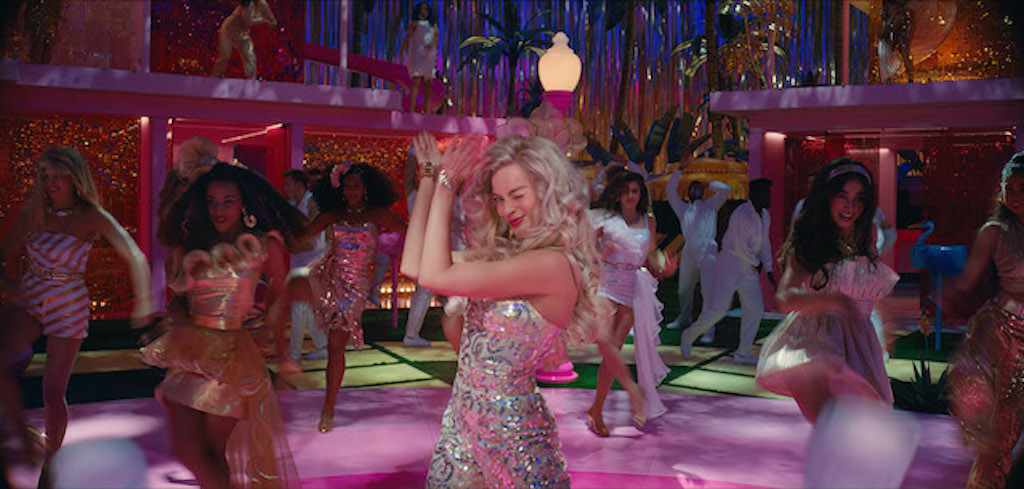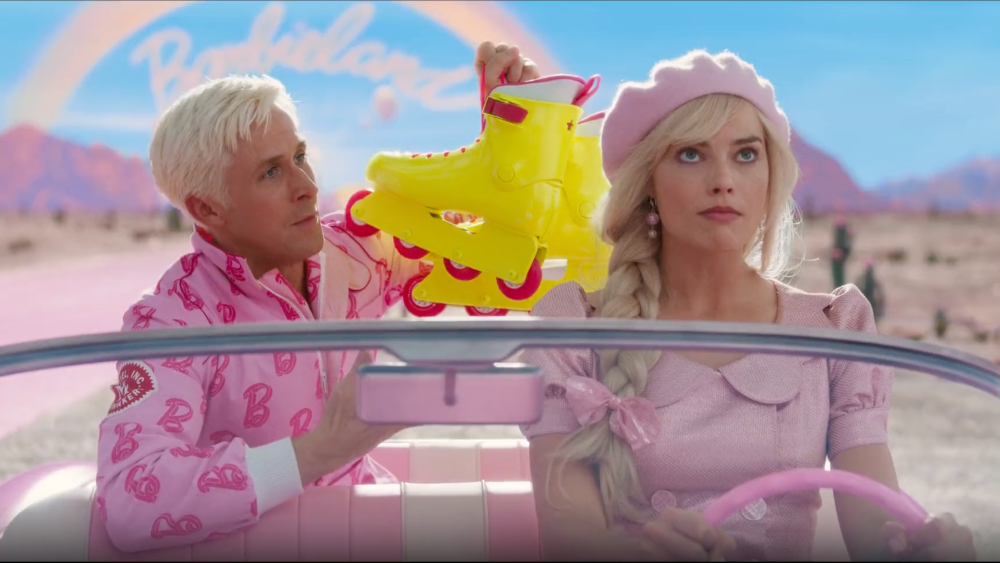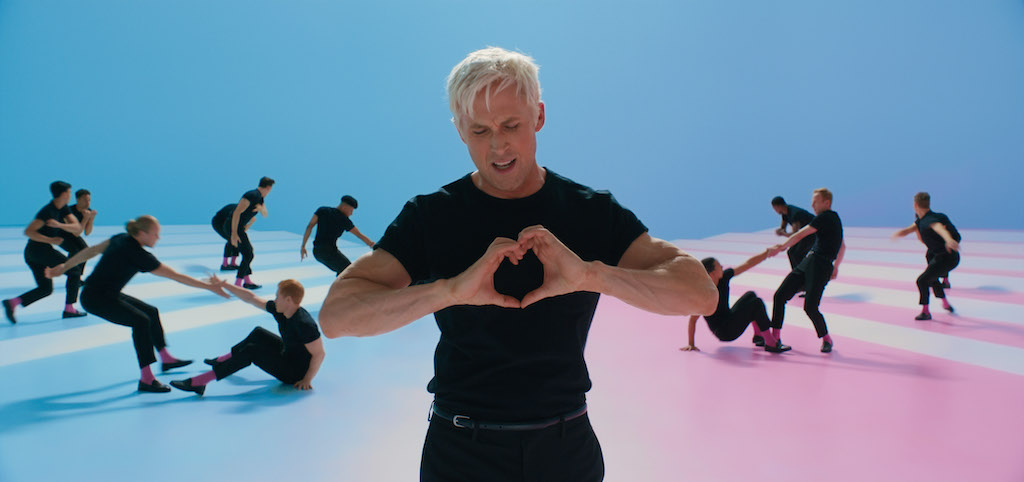
A global phenomenon, Barbie reimagines the Mattel doll and her world in ways that fascinate viewers. The script, by Director Greta Gerwig and Noah Baumbach, examines how Barbie (played by Margot Robbie) came into being by giving her an existential crisis. Ken (Ryan Gosling) follows her into the “real” world, where they ponder death and imperfection.
Joining in the cast are America Ferrera, Kate McKinnon, Issa Rae, Rhea Perlman, Simu Liu, and Will Ferrell. The film’s extraordinary production design was by Sarah Greenwood with Katie Spencer as set designer. Behind the equally impressive makeup and hair design, Ivana Primorac.
Barbie is the second project this year for Rodrigo Prieto, ASC, AMC. The award-winning cinematographer was working on Killers of the Flower Moon when he first took Zoom meetings with Gerwig. Rodrigo joined the team after finishing the Martin Scorsese film.
We spoke with Prieto at the 31st EnergaCAMERIMAGE Film Festival, where he had previously won awards for Amores Perros and Alexander.
Below the Line: When did you start on Barbie?
Rodrigo Prieto: I was prepping Killers of the Flower Moon when Greta called. I was in Bartlesville, Oklahoma. Some Sundays we’d Zoom, but I was in the middle of research for Killers. To go from that to talking about what shades of pink we would use, I really had to shift gears. After three or four conversations I asked Greta if we could wait until I finished Killers.
BTL: Barbie takes place in two entirely different worlds. How did you approach that as a cinematographer?
Prieto: The first thing is, we know what the real world looks like. What does “Barbieland” look like? Greta had many references, as did Sarah Greenwood. They would send them to me via email or Dropbox.
A big part of Greta’s approach was what she called “artificial authenticity.” She wanted Barbieland to feel artificial, yet be authentic within that concept. Embrace the studio setting, try to achieve the feeling she got from movies she loved like The Wizard of Oz and Singin’ in the Rain. You know you’re on a stage. You can see the painted backdrops.
We started exploring what that meant, how much we wanted to feel those walls. I interpreted the concept to mean that for the Barbies and the Kens, it’s a real world. It had to feel like a place where they live and they function, you know? It’s a tricky balance. You have a beach, for example. How do you feel a wall in a set that’s supposed to be a beach?

BTL: When you’re in the real world, you can’t be too visually different without possibly jarring viewers.
Prieto: During discussions we talked about the differences. At one point we even considered shooting the real world hand-held. Or maybe shooting that on film versus shooting Barbieland on digital. But to really understand the difference we had to understand how to do Barbieland.
That process began when I got to London and started testing. Greta hadn’t shot a feature on digital yet, and she was still thinking about doing Barbie on film. I love film, but I felt that Barbieland had to be perfect—at least until things start to malfunction. That meant a clean image with no grain.
We shot tests of the same image with stand-ins and all the colors of Barbieland. We shot it on film and on various digital cameras. I liked the idea of using the Alexa 65 because with that bigger sensor we’d get a slightly shallower depth of field, which reinforced the feeling of being inside a miniature. Greta agreed. Then we tested lenses, and settled on the System 65 lenses from Panavision.
The next step was creating a LUT (look up table) for these colors. I had a LUT for Killers that emulated three-strip Technicolor, but it didn’t quite work for Barbieland because it was made for primaries, reds and greens and blues. So we started tweaking it with Yvon Lucas at Efilm. It took a while because we had a lot of colors and a lot of skin tones.
It was a tricky process but we got something Greta really liked. She named it TechnoBarbie because it was based on Technicolor.
We ended up not shooting on film for the real world. We used an Alexa LF and Mini LF with a LUT that basically emulated Kodak 5219 film stock.
BTL: When I talked to Sarah Greenwood, she said one problem with the pinks was that they would change color depending on the lighting.
Prieto: Certainly. Depending on the angle of light, that happens with any color, but even more so with the LUT we were using.
We were trying to get the sensation of purity or innocence in Barbieland. Yes, we’re on a soundstage, but I wanted it to feel like an exterior as well. So we decided that it’s always sunny in Barbieland. Not only that, but it’s always backlit. In every shot, the sun is backlighting the characters, because that’s prettier, right?
I used SoftSuns, which are really big, bright 100K lights, for the backlighting. We rigged several of them so we could move around quickly, turning them on and off. If we were within a shot, moving the camera, we dimmed down one sun and brought up the other so we’d stay backlit in any direction. It was a little surreal.
To get back to your question, what happened as soon as I turned the sun on, everything behind the camera would bounce light onto the faces. Very saturated pinks and yellows, which made the skin tones very difficult to manage.
We had to get tons of neutral gray fabric to drape over everything that was off camera. That became a big part of the lighting. First, what’s the angle? Then, what’s out of shot? Covering everything with gray to avoid a pink reflection.

BTL: Were you shooting with miniatures?
Prieto: Greta wanted the world Barbie lived in to feel like a miniature, but at the same time they’re human-sized characters. So it’s this in-between world where they’re real sized, but things look like toys.
We didn’t have enough time to make miniatures, which would have been really tricky for all the scenes. The one miniature we shot was “Weird” Barbie’s (Kate McKinnon) house. Sarah’s team made many other miniatures, which the visual effects department scanned for the later CG elements.
When Barbie’s driving around town, everything you see is based on a miniature, even though they were put together and lit by CG. We actually filmed those scenes on a volume set. So when Barbie’s driving, the car isn’t moving. Even the wheels of the car turn in CG. We did rig a camera on a moving car when it was inside the cul-de-sac.
BTL: Gerwig said the transition scenes to the real world were practical builds.
Prieto: Yes, that desert scene is a real set with a piece of road. We put blue screens on the edges and used set extensions. Those shots of the car turning into the spaceship, that’s not CG. It was done in a very theatrical fashion. The vehicles don’t move, the camera doesn’t move. Everything else is moving. So when the car is driving, there are people pulling the lines on the road with strings. And the landscapes move at different speeds, faster in close, slower farther away.
That took a lot of design, figuring out the field of view, what lens to use, how to time the shot so the backgrounds wouldn’t run out. It was actually very fun to shoot.
I think the effect is charming. It brings back the magic of theater, the make-believe when it’s just a little stage and puppets. It allows us to believe in storytelling we know is fake. That’s important for Barbie and Ken because they’re innocent, but starting to become adults in a way.

BTL: In The Wizard of Oz, you know it’s a fake house falling into a fake world, but you still want to believe.
Prieto: Exactly. It’s something I loved when I started making 8mm stop-motion films. I was inspired by Willis O’Brien and Roy Harryhausen. I knew they were using puppets, but that was what made the films awesome. The fact that it was an actual thing you could touch and move, that was magic to me.
BTL: How did you collaborate with Gerwig in terms of shotlists and storyboards?
Prieto: We did extensive storyboards, many, many sessions. We had a storyboard artist for probably 80% of the film. And we pretty much stuck to them.
Part of the idea was that in Barbieland the camera would behave in a mechanical way. It just goes straight with Barbie. When she’s walking, the camera’s at exactly the same distance tracking with her, or pushing in, or tracking back. No fancy diagonal moves, you know?
The camera was usually on a Technocrane, sometimes a dolly. We discussed what the camera was doing for every scene. We had to design shots beforehand, to figure out if we needed wild walls or anything like that. We had to be very specific. Barbie’s dream house had very few walls. There’s nothing we could remove there.
We allowed ourselves to be a little looser in the real world. Barbie discovers the beauty of imperfection, so we wanted the camera to behave that way too. In Barbieland we used wide lenses, because nothing is hidden. In the real world, we used longer lenses, and we didn’t storyboard as much.

BTL: What time of day is it in Barbieland?
Prieto: It changes, but for the most part I’d say the look is 9:30 in the morning. Usually you would use gels to adjust the lighting for different times of day. But I couldn’t gel the SoftSuns because we needed motors to tilt them. What I did instead was use SkyPanels to create ambient light. I had dimmer operators adjust the color temperature of those to move a scene closer to sunset.
BTL: I’m guessing this was mostly single camera?
Prieto: Yes. We did have a B camera for dance numbers and things like that. But even for those, the main shots were designed for a single camera. In fact, the inspiration for the dance scenes was Bob Fosse. You don’t think All That Jazz for Barbie, but his choreography was always designed for the camera.
That was our approach, too. We worked very closely with the choreographers to make sure they were aware of specific frames and camera movements. You can really see it in the “Dream Ballet,” which is what Greta called the number with all the Kens dressed in black with pink socks. Every shot there was designed for the camera.
I went to the rehearsals with a viewfinder. The choreographers were also working with their phones to come up with possible angles. With Greta, we would get more specific about focal lengths.
For that dance I turned off the fill lights. I had one 200K SoftSun, the biggest one they have. It created these patterns of shadows on the floor that I found really beautiful. That very high-angle wide shot, with the graphic of the floor and the dancers in black and their shadows, is one of my favorites in the movie. Everything came together, the lighting, the production design, the costume design. I think we had a 75-foot crane for that shot, the camera was almost touching the ceiling of the stage.
It’s one of those things you design and think about. But only when it’s actually in front of you, do you realize that it works.
Barbie is now available to own on Blu-Ray.





